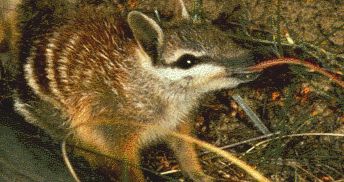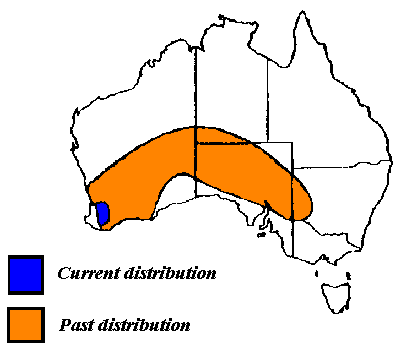The Numbat - An
Endangered Species
 he Numbat, or Mymecobius fasciatus, - myrmex meaning ant, bios meaning life and fasciatus meaning banded or striped - is the sole member of the Myrmecobiibae family. A West Australian marsupial, although it does not posses a pouch and is diurnal (active by day), it is the faunal emblem of the state. It is a timid and gentle creature and can be startled easily. It is found only in Australia. The head and body length are around 25 cm (9.8 in), while the large, bushy tail is about 18.5 cm (7.3 in) in length and covered in long brown hair, some of them white tipped. The fur on the body is a reddish brown with a white underside, four to sixteen distinctive black and white bands on the rump and lower back and a horizontal black stripe starting at the bottom of the ear and continuing right through the eye to the nose. They can be identified by their individual pattern of bands. Females can weigh about 460g and males, who are usually heavier, around 480g. With their small head, pointed nose and very long tongue they search around in the undergrowth looking for termites and termite ridden logs. Having found one of these they break in and extract the termites using their very long and sticky tongue. It is the only marsupial, along with the echidna, to have a diet consisting mainly of termites. An adult Numbat, with it's 50 to 52 teeth, will eat from 15,000 to 20,000 termites everyday. Therefore in captivity, as it virtually impossible to collect so many termites a day, a special egg custard mix, with vitamin supplements and 10% termites has been developed as a substitute.
he Numbat, or Mymecobius fasciatus, - myrmex meaning ant, bios meaning life and fasciatus meaning banded or striped - is the sole member of the Myrmecobiibae family. A West Australian marsupial, although it does not posses a pouch and is diurnal (active by day), it is the faunal emblem of the state. It is a timid and gentle creature and can be startled easily. It is found only in Australia. The head and body length are around 25 cm (9.8 in), while the large, bushy tail is about 18.5 cm (7.3 in) in length and covered in long brown hair, some of them white tipped. The fur on the body is a reddish brown with a white underside, four to sixteen distinctive black and white bands on the rump and lower back and a horizontal black stripe starting at the bottom of the ear and continuing right through the eye to the nose. They can be identified by their individual pattern of bands. Females can weigh about 460g and males, who are usually heavier, around 480g. With their small head, pointed nose and very long tongue they search around in the undergrowth looking for termites and termite ridden logs. Having found one of these they break in and extract the termites using their very long and sticky tongue. It is the only marsupial, along with the echidna, to have a diet consisting mainly of termites. An adult Numbat, with it's 50 to 52 teeth, will eat from 15,000 to 20,000 termites everyday. Therefore in captivity, as it virtually impossible to collect so many termites a day, a special egg custard mix, with vitamin supplements and 10% termites has been developed as a substitute.
Females are sexually mature at about 12 months. Mating occurs during the summer months and fourteen days later the female will give birth to up to four young. As with all marsupials the young are born prematurely, and because the mother has no pouch, the young will attach themselves to the mother's four teats and the long hair around them. The mother will suckle them for six months. After ten months, the young will get to heavy to carry around and so the mother will dig a burrow and leaves them there whilst she goes and looks for food. She will return at night to suckle them though. If the mother has to move nest, the young will ride on her back. The burrow can be up to two metres long with a nest at the end made of bark and leaves. Entrances are hidden under logs or piles of branches. Their natural predators are mainly Carpet Pythons and birds of pray, such as Brown Goshawks, Little Eagles and Collared Sparrowhawks. Feral animals and foxes also are some predators that have been introduced by humans. Being solitary and territorial animals, once a young numbat has established its own territory (usually around 370 acres - 150 ha) it will keep in or near that area for the rest of its life. Apparently, numbats have been known to wander 15 km in one day.
Numbats used to range in small numbers across almost all the southern half of Western Australia, nearly all of South Australia, and a little bit of lower Northern Territory and western New South Wales. In the 1950s Numbats were widespread in the southern half of Western Australia but disappeared from the region between the 1950s and the 1970s. By 1986 only two populations still existed. Now 90% of their former range has been destroyed by mainly by foxes and agricultural means, and also by feral cats and dogs. Now they are found only in south west Western Australia, mostly in shrubby eucalypt woodlands in wettest parts of their former range.
Here is map showing the current and past distribution of numbats:
Here are some pictures of numbats:
A numbat sitting
on a log
|
A numbat looking
in the underbrush
|
Two young numbats
playing around
|
A numbat investigating
a termite ridden log
|

numbat2.jpg | 26 KB
|

numbat3.jpg | 40 KB
|

numbat4.jpg | 62 KB
|

numbat5.jpg | 41 KB
|
I would like to thank the Environment Australia - Biodiversity Group's numbat
page for the numbat distribution map (which I have changed slightly).
I would also like to thank that page and numerous other pages and
books, which I used for reference.
You can email me at: [email protected] .
Visit my home page - Sebastian's Star Wars Home Page - at: http://members.tripod.com/~hansolo1221/
Last updated: 2:05 PM on Tuesday the 23rd of November, 1999.


 he Numbat, or Mymecobius fasciatus, - myrmex meaning ant, bios meaning life and fasciatus meaning banded or striped - is the sole member of the Myrmecobiibae family. A West Australian marsupial, although it does not posses a pouch and is diurnal (active by day), it is the faunal emblem of the state. It is a timid and gentle creature and can be startled easily. It is found only in Australia. The head and body length are around 25 cm (9.8 in), while the large, bushy tail is about 18.5 cm (7.3 in) in length and covered in long brown hair, some of them white tipped. The fur on the body is a reddish brown with a white underside, four to sixteen distinctive black and white bands on the rump and lower back and a horizontal black stripe starting at the bottom of the ear and continuing right through the eye to the nose. They can be identified by their individual pattern of bands. Females can weigh about 460g and males, who are usually heavier, around 480g. With their small head, pointed nose and very long tongue they search around in the undergrowth looking for termites and termite ridden logs. Having found one of these they break in and extract the termites using their very long and sticky tongue. It is the only marsupial, along with the echidna, to have a diet consisting mainly of termites. An adult Numbat, with it's 50 to 52 teeth, will eat from 15,000 to 20,000 termites everyday. Therefore in captivity, as it virtually impossible to collect so many termites a day, a special egg custard mix, with vitamin supplements and 10% termites has been developed as a substitute.
he Numbat, or Mymecobius fasciatus, - myrmex meaning ant, bios meaning life and fasciatus meaning banded or striped - is the sole member of the Myrmecobiibae family. A West Australian marsupial, although it does not posses a pouch and is diurnal (active by day), it is the faunal emblem of the state. It is a timid and gentle creature and can be startled easily. It is found only in Australia. The head and body length are around 25 cm (9.8 in), while the large, bushy tail is about 18.5 cm (7.3 in) in length and covered in long brown hair, some of them white tipped. The fur on the body is a reddish brown with a white underside, four to sixteen distinctive black and white bands on the rump and lower back and a horizontal black stripe starting at the bottom of the ear and continuing right through the eye to the nose. They can be identified by their individual pattern of bands. Females can weigh about 460g and males, who are usually heavier, around 480g. With their small head, pointed nose and very long tongue they search around in the undergrowth looking for termites and termite ridden logs. Having found one of these they break in and extract the termites using their very long and sticky tongue. It is the only marsupial, along with the echidna, to have a diet consisting mainly of termites. An adult Numbat, with it's 50 to 52 teeth, will eat from 15,000 to 20,000 termites everyday. Therefore in captivity, as it virtually impossible to collect so many termites a day, a special egg custard mix, with vitamin supplements and 10% termites has been developed as a substitute.